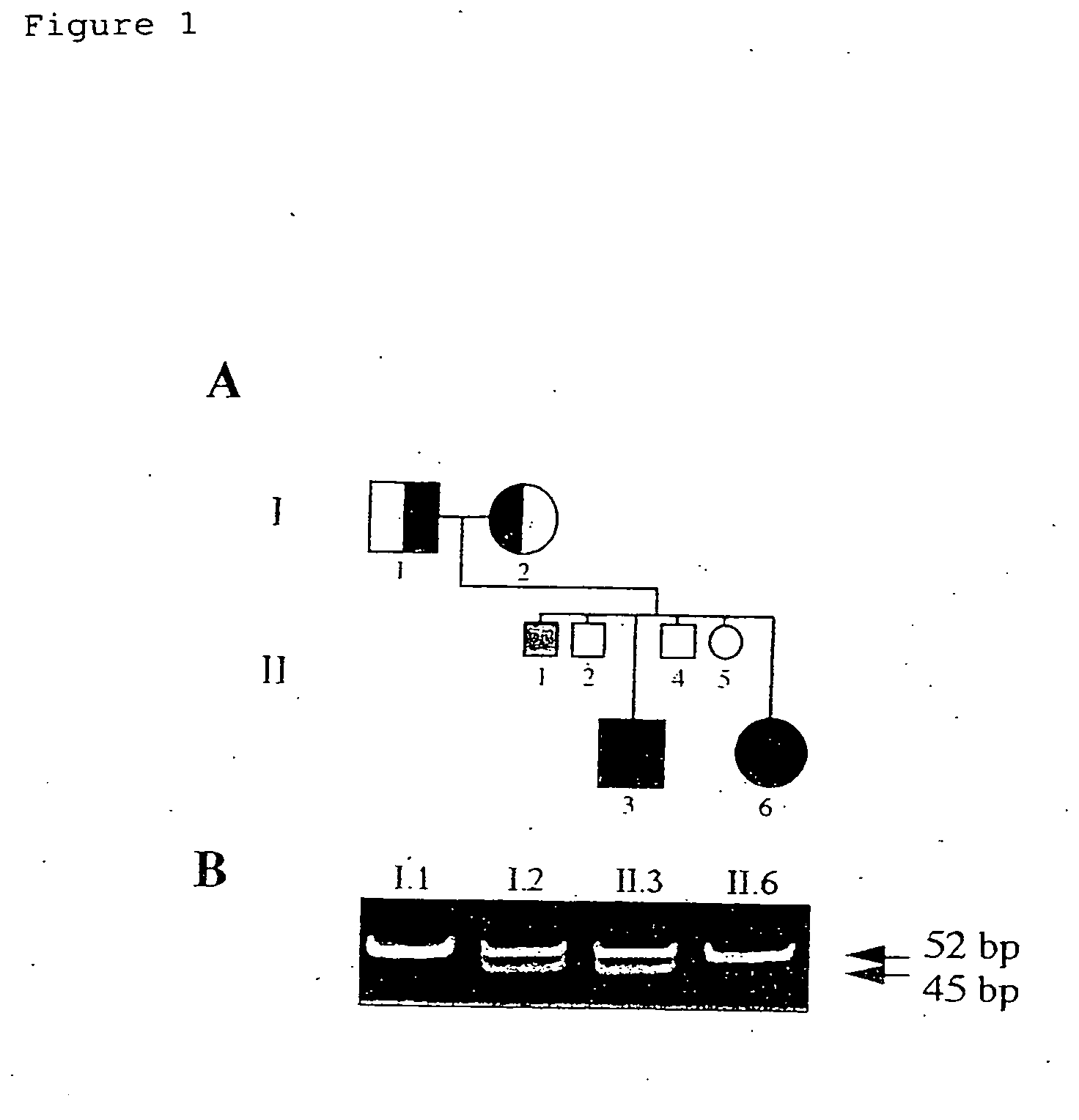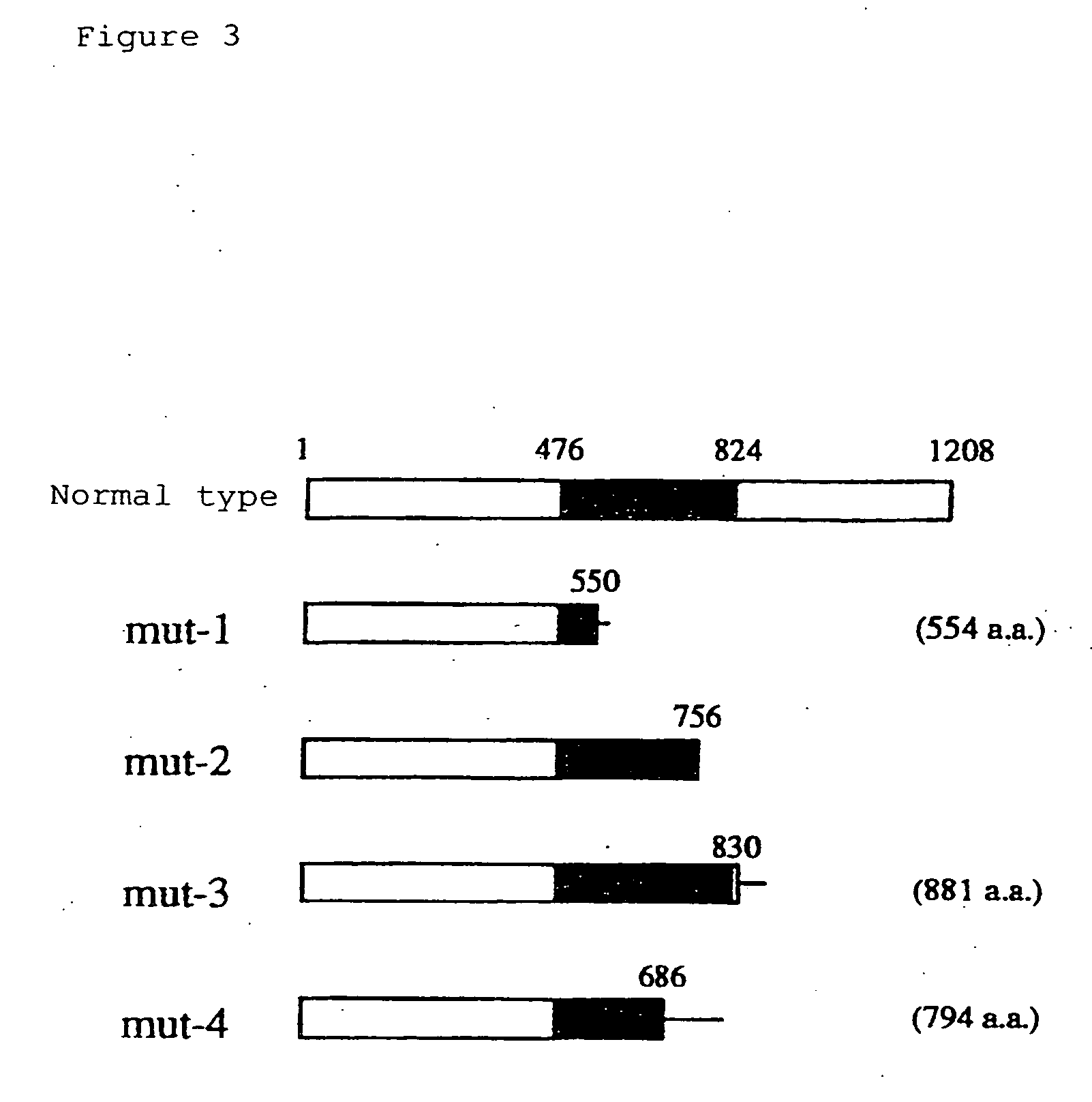Gene causative of Rothmund-Thomson syndrome and gene product
a technology of rothmund-thomson syndrome and gene product, which is applied in the direction of fluid pressure measurement, fluid/fluent solid measurement, peptide measurement, etc., can solve problems such as genetic instability, and achieve the effect of easy and efficient diagnosis
- Summary
- Abstract
- Description
- Claims
- Application Information
AI Technical Summary
Benefits of technology
Problems solved by technology
Method used
Image
Examples
example 1
Genomic DNA Cloning of the RecQ4 Helicase Gene
[0115] The genomic DNA of the human RecQ4 helicase gene was obtained by screening a P1 / PAC library. The P1 / PAC library used was obtained from Genome Systems, and the preparation method is described in the Smoller et al. reference (Smoller, et al., Chromosoma, 1991, vol. 100, pp 487-pp 494). The screening was carried out by PCR using a sense primer, Q4P (5′-CGC TTC TGG AGA AAA TAC CTG CAC-3′ / SEQ ID NO: 9), and an antisense primer, Q4Q (5′-TTG GAG CCT CCT CGT TCC CAC ACC-3′ / SEQ ID NO: 10), corresponding to the base sequence segments in exon 21 of the RecQ4 gene. The screening was carried out in Genome Systems Co. The isolation and purification of DNA from P1 clone #13447 obtained in the screening was performed by the method as descried in the reference (Smoller, et al., Chromosoma, 1991, vol. 100, pp 487-pp 494). The genomic base sequence of the RecQ4 gene was determined by using the purified P1 DNA as the template. The determined base se...
example 2
Cloning of the Promoter Region of the RecQ4 Helicase Gene
[0117] DNA from P1 clone #13447, containing the genomic DNA of the human RecQ4 helicase gene, was digested with restriction enzymes BamHI and BglII (TaKaRa Shuzo), and the plasmid vector pBluescriptII KS+ was digested with BamHI. The resulting digested DNAs were mixed with each other and then T4 DNA ligase (TaKaRa Shuzo) was added thereto for ligation reaction. E. coli competent cells, DH5α (Toyobo), were transformed with the reaction product and the resulting E. coli colonies were screened by PCR to determine whether or not the DNA from each colony contained a 5′ upstream region of human genomic DNA of RecQ4. The screening for clones containing the 5′ upstream region was carried out by using a sense primer, Q4 S (5′-TCA CAA CTT CTG ATC CCT GGT GAG-3′ / SEQ ID NO: 5), and an antisense primer, Q4 R (5′-GAG GGT CTT CCT CAA CTG CTA CAG-3′ / SEQ ID NO: 6), for amplifying a 247-bp segment of genomic DNA of RecQ4 sequence (residue 1399...
example 3
Detection of Mutations in the RecQ4 Helicase Gene in Patients with Rothmund-Thomson Syndrome
[0118] The inventors had previously cloned and analyzed two novel human helicase genes, RecQ4 and RecQ5, belonging to the RecQ helicase gene family (see Japanese Patent Application No. Hei 9-200387; Japanese Patent Application No. Hei 10-81492; and Kitao, S. et al., Genomics, 1998, vol. 54, pp 443-pp 452). Together, with these two novel genes, there are 5 members belonging to the human RecQ helicase gene family, including RecQ1 (M. Seki et al., Nucleic Acids Res. 22:4566 (1994); K. L. Puranam et al., J. Biol. Chem. 269:29838 (1994)), BLM (N. A. Ellis et al., Cell 83:655 (1995)), WRN (C.-E. Yu et al., Science 272:258 (1996)), RecQ4 and RecQ5.
[0119] Northern blot analysis for these five RecQ helicase genes revealed that, RecQ5, like RecQ1, was observed to be ubiquitously expressed through all the tissues and organs, while markedly high level expression was observed in the thymus and testis an...
PUM
 Login to View More
Login to View More Abstract
Description
Claims
Application Information
 Login to View More
Login to View More - R&D
- Intellectual Property
- Life Sciences
- Materials
- Tech Scout
- Unparalleled Data Quality
- Higher Quality Content
- 60% Fewer Hallucinations
Browse by: Latest US Patents, China's latest patents, Technical Efficacy Thesaurus, Application Domain, Technology Topic, Popular Technical Reports.
© 2025 PatSnap. All rights reserved.Legal|Privacy policy|Modern Slavery Act Transparency Statement|Sitemap|About US| Contact US: help@patsnap.com



